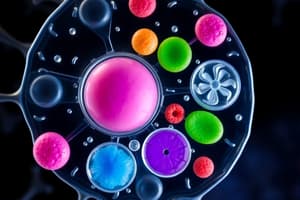Podcast
Questions and Answers
Who are the three key figures in establishing cell theory?
Who are the three key figures in establishing cell theory?
- Charles Darwin, Gregor Mendel, Louis Pasteur
- Matthias Schleiden, Theodor Schwann, Rudolf Virchow (correct)
- Anton van Leeuwenhoek, Robert Hooke, Carolus Linnaeus
- Marie Curie, Albert Einstein, Isaac Newton
What did Virchow add to the cell theory?
What did Virchow add to the cell theory?
- Cells are the building blocks of life
- Cells have unlimited regenerative capacity
- Cells must be observable with the naked eye
- Cells only arise from preexisting cells (correct)
Which of the following is NOT a component of a cell?
Which of the following is NOT a component of a cell?
- Mitochondria
- Ribosome
- Endoplasmic Reticulum (correct)
- Lysosome
What is the function of the nucleus in a cell?
What is the function of the nucleus in a cell?
Which scientist is known for groundbreaking microscopic observations that contributed to cell theory?
Which scientist is known for groundbreaking microscopic observations that contributed to cell theory?
What does cell theory state about new cells?
What does cell theory state about new cells?
Where does most cellular activity take place?
Where does most cellular activity take place?
Which category of cells has genetic material enclosed in a nucleus?
Which category of cells has genetic material enclosed in a nucleus?
What is the primary function of the cell membrane?
What is the primary function of the cell membrane?
Which organelle is responsible for converting sunlight into organic compounds?
Which organelle is responsible for converting sunlight into organic compounds?
Who made the earliest microscopic observations leading to the development of cell theory?
Who made the earliest microscopic observations leading to the development of cell theory?
Which type of cell does not have a nucleus or membrane-bound organelles?
Which type of cell does not have a nucleus or membrane-bound organelles?
Study Notes
Understanding Cell Theory
Cell theory is a fundamental concept in biology that explains the nature of all living entities. Developed over centuries through groundbreaking microscopic observations and experiments, cell theory describes the basic attributes of cells—their role in life and reproduction.
Three key figures in establishing cell theory are Matthias Schleiden (botanist), Theodor Schwann (zoologist), and Rudolf Virchow (physician). Together, they presented the unified cell theory in 1839, stating that:
- All living things are composed of one or more cells.
- Cells are the basic units of structure and function in living things.
- New cells arise from existing cells through cellular division.
Later, Virchow added to cell theory, emphasizing that cells only arise from preexisting cells ("omnis cellula e cellula"). Although spontaneous generation, meaning the creation of new cells from nonliving materials, was initially a popular belief, Virchow's findings dismissed the notion entirely.
Cell Components and Function
The cell is designed to carry out vital functions essential for life, including maintaining metabolic processes, growth, and response to external influences. Cells possess several internal components that facilitate their purpose, such as:
- Nucleus: Contains genetic material, DNA, that dictates cell behavior and heritable traits.
- Cytoplasm: Where most cellular activity takes place, containing proteins, enzymes, and organelles like mitochondria and ribosomes.
- Membrane: Selectively allows entry of materials required for cellular processes, while preventing unwanted intrusions.
Cell Types and Diversity
There are two primary categories of cells based on differences in their complexity and characteristics:
- Eukaryotic cells: With segregated genetic material housed within a nucleus surrounded by a nuclear envelope, eukaryotic cells represent the majority of cells in multicellular organisms. Examples include human, plant, fungal, and algal cells.
- Prokaryotic cells: Without a nucleus or any other membrane-bound organelle, prokaryotic cells are simple and ubiquitous forms of life often associated with one-celled organisms like bacteria.
These cell types serve diverse roles across the spectrum of life, from breaking down waste within animal digestion systems to converting sunlight into organic compounds in photosynthesis.
Historically, the development of cell theory is intertwined with the evolution of the microscope, enhanced imagery techniques, and the gradual recognition of the importance of small organic structures. From the earliest microscopic observations by Robert Hooke in the mid-17th century to the rigorous scientific analysis by Schleiden, Schwann, and others, cell theory emerged as the comprehensive understanding of life founded on the existence and organization of cells.
Studying That Suits You
Use AI to generate personalized quizzes and flashcards to suit your learning preferences.
Description
Test your knowledge on cell theory, components, and types with this quiz. Learn about the key figures in establishing cell theory, the components of cells like nucleus and cytoplasm, and the differences between eukaryotic and prokaryotic cells.




